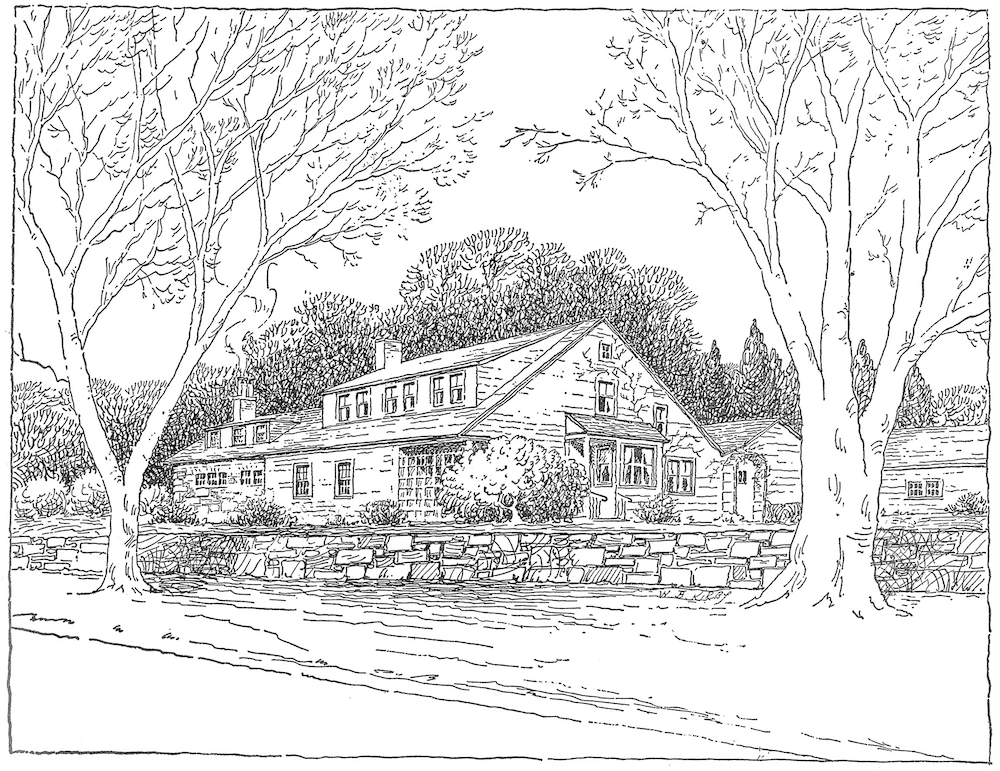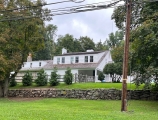4 Beacon Hill Lane
‘New Canaan Now & Then’ is sponsored by Brown Harris Stevens Realtors Joanne Santulli, Karen Ceraso, Bettina Hegel and Schuyler Morris.
The 1765 Alma Colbron House located at 4 Beacon Hill Lane (what was then East Avenue) is one of the oldest homes in New Canaan.
It was built by John Benedict and his son, John Benedict Jr. of Norwalk. The Benedicts acquired land as early as 1702, and the house is listed in land records as owned by John Benedict Jr. in 1765, when he was 89 years old. The house has a traditional center chimney that serviced several fireplaces and a brick oven in the kitchen. The porches and rooms were added at a later date, but the house is largely a traditional colonial saltbox.
The rich history of the house is reflected in the many owners that were influential figures in New Canaan history. John Benedict sold the home to Samuel Lawrence from New York, who traded in country real estate. Lawrence sold the land to Lindall Fitch in 1771. Fitch was a descendant of Henry Lindall, a deacon in the first church of New Haven. His grandfather on his mother’s side was Thomas Fitch, a founder of Norwalk. Lindall Fitch married Mary Bartlett, the granddaughter of William Haynes who had been granted 93 acres of land by the Norwalk Proprietors (near Lambert Road). The auspicious union of Fitch and Bartlett was followed by their own daughter, Elizabeth, marrying Justus Hoyt. Lindall Fitch died according to the Drummond Visitation notes at the age of 56 from “consumption and gravel.”
Seymour Fitch, Mary and Lindall’s son, handled the estate of his father and sold the property to David Hoyt Jr. in 1774. David and his young wife, Rebecca Webster, were married in 1773. The Hoyts had three children: Jacob, Rebekah and Rumahah. In 1793 they sold their home to Enoch [k] Comstock and moved to Greenfield, New York in Saratoga County.
Enoch Comstock paid 70 pounds for the estate which was reportedly 5 pounds less than David Hoyt paid the Fitch Estate. Enoch was the son of Abijah Comstock of Silvermine. He was 43 years old at the time and was married to Anna Weed. The pair had a number of children who anecdotally were tough on their shoes – Enoch’s name appears repeatedly in a “day book” kept by an early New Canaan shoemaker. The Comstocks sold the house in 1795 for 80 pounds to Jacob Selleck. Another interesting fact about the house at Beacon Hill Lane is that during the Revolutionary War, Enoch Comstock opened his doors to refugees from Norwalk after the British burned the city. As a reward for his patriotic act, the State of Connecticut gave him 2000 acres in the “western preserve” which is the site of Norwalk Ohio.
Selleck sold the property to Nathaniel Ells in 1797 and in 1800 the property changed hands again to Peter St. John Jr., who was an apprentice shoemaker at the age of 16 and then joined the army. In 1800 he was married to Rachel Jones and they had three children. The St. Johns’ relocated to New York State and sold the property to Andress Powers in 1802 for $1000; it included 7.5 acres, barn, and adjacent land. Andress Powers was the grandson of one of the Canaan Parish founders – Theophilus Hanford. Powers married the niece of Enoch Comstock, Deborah Comstock in 1797. Powers was a cooper (barrel maker), and he and Deborah relocated to Marietta Ohio in 1804, following Andress’s brother, Theophilus.
Ebenezer Carter was the next owner of the property. Ebenezer was the son of Samuel Carter who had moved from Deerfield Massachusetts to Norwalk and had begun the long run of Carters in town. Ebenezer paid $1763 for 30 acres of land, dwelling house, out houses, and barn. A year later Carter sold the home to Thomas Greenley. Greenley purchased 12.5 acres, a dwelling house, barn and shop (presumably erected by Powers for his barrels) and 10 acres on the highway for $1100.
The Greenleys, unlike the other tenants, were not descendants of settlers of Canaan Parish but were Londoners. Greenley applied to the General Assembly of the State of Connecticut for the right to own property earlier in 1805 and his petition was granted. Greenley almost immediately launched a distillery business. He purchased nearby land and a distillery from Nathan Hanford, and then in 1814 increased his land holdings by purchasing 50 rods south of his land for his distillery. In 1823 he again purchased “the still house meadow” from the Husteds.
It is speculated that Greenley is responsible for adding the long front porch to the house. Thomas Greenley, his wife Esther and their two daughters Emma and Eliza owned the property until 1846.
[Part 2 of this “New Canaan Now & Then” installment will be published next week.]



All the familiar names and intermixed families presented in this featured Alma Cobron house article are so interesting! This excellent series put together for the Newcanaanite by the Brown Harris Stevens Realtors group has been facinating! So many connections in this latest story to families buried in the Maple Street Cemetery which is located right in the center of our town and which served as a link between the close of the Church Hill Burial Ground and the opening of Lakeview Cemetery. Anyone who would like to visit this ancient burial ground enters through the visitor’s parking area off Maple Street, at the VUE, then follows the walk along the first building, turns left on the walk to the children’s playground, and just beyond, the entrance to the the burial ground! …Perhaps this realtors writers’ group could suggest some historic signs be strategically located in places they have been featuring. This would be a wonderful help in putting together walking tours, promoting the history of our community, an incentive for others to plan local history forums, raise funds for signage and sponsor programs for visitors and newcomers to introduce them to the Town. Many thanks to the Newcanaanite and to the authors of these facinating and well researched articles!
Thanks Terry. The history articles are written by the New Canaan Museum & Historical Society.